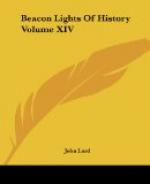But the most surprising discoveries in the realm of old Greek history and art are those that have been made in these last two or three years in Crete. Crete was a famous centre of ancient Greek legend. Jupiter was born and reared on Mount Ida. From another mountain summit in Crete the gods watched the battle on the plains of Troy. There ruled Minos, who first gave laws to men, and who at his death was sent by the gods to judge the shades as they entered the lower world. There was the famous Labyrinth, and there the Minotaur devoured his annual tale of maidens until he was slain by Theseus. Was there such a real palace of Minos as the Greek poets sung? The magnificent palace of the Cretan kings at Cnossus has been found, by Mr. Evans, with its friezes, its spiral ornaments, its flounce-petticoated women, its treasuries, and its tablets written in a script so old that it cannot yet be read, but which will be read as surely as scholarship leaves none of its riddles unsolved. The childhood of Greece, its mighty infancy, out of which it grew to be the creator and the example of all the world’s culture, is even now being exposed to our view, safely kept to be recovered by the scholars of our generation.
Of interest rather to the student of the curiosities of history are the mounds and pyramids and temples built by the aborigines of America; for these tribes have had absolutely no part in creating our dominant civilization or developing its art. China and Japan are, at this late day, giving something to the world’s store of beauty and utility; but the mound-builders and cliff-dwellers, the Mayas and Toltecs and Incas, have given absolutely nothing which the world cared to accept. But this does not argue that it is not worth while to learn what we can of the rude civilization of the races whom we have displaced. Their arrowheads and hatchets are in every little museum. Their mounds, sometimes shaped like serpents or tortoises or lizards, are scattered over all the central States, and many of them have been carefully explored with scanty results. The cliff-dwellers have left somewhat richer remains, more baskets and parched corn, yet nothing of artistic value. We have to go to Mexico and Yucatan and further south to Peru, to find the majestic capitals of the Mayas and Incas, who had really reached a fair degree of such civilization as stone and copper, without iron, and the beginnings of picture symbols, without letters, could provide. Humboldt and Stephens, and Lord Kingsborough, and Squier, and Tchudi, and Charnay have made explorations and found vast and wonderful cities, some of them deserted and overgrown before Cortez and Pizarro took possession of the lands for Spain and enslaved the people. Where the city of Mexico now stands was a famous capital, from whose ruins were taken the great Calendar stone and the double statue of the god of war and the god of death. In Palenque and Uxmal, capitals of Yucatan, were immense




